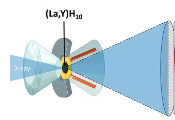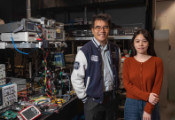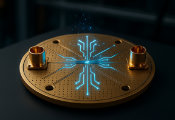Mind-Controlled Prosthetics and More: Q.ANT Revolutionizes Biosensing
Stuttgart, October 16, 2024 -- Q.ANT, the leading German startup for light-based data processing and quantum sensing, is unveiling the first prototypes of the Q.M 10, the next generation of its photonic quantum magnetic field sensor. This groundbreaking sensor redefines the way biosignals are captured and processed in medical technology by measuring the tiniest electric currents and magnetic fields in the human body with even greater precision than its predecessor, and without direct contact. By leveraging light as a natural carrier of information, the Q.M 10 gives researchers deeper insights into the body’s biosignals and promises to push the boundaries of medical technology. One example is mind-controlled prosthetics that function almost like natural limbs. In collaboration with the Fraunhofer Institute for Manufacturing Engineering and Automation (IPA), Q.ANT is developing an innovative prosthetic sensor module, showcasing it at this year’s COMPAMED international trade fair in Düsseldorf, taking place from November 11-14. Visitors can experience a live demonstration at Hall 8a, Booth G10, demonstrating how the Q.M 10 converts emulated muscle signals into precise commands for a hand prosthesis in milliseconds.
Availability
The Q.M 10 will be available starting in April 2025 and can be pre-ordered immediately. Until the end of 2024, Q.ANT invites researchers and product developers to join the “Q.M 10 Early Adopter Program.” Early access to initial sensors, collaborative product development workshops, AI-driven data analysis, and tailored business models offer participants a competitive edge before the official market launch of the Q.M 10. “The Q.M 10 marks a turning point in medical sensing. Its unique ability to perform ultra-sensitive measurements under normal environmental conditions makes it a versatile tool for a wide range of developmental fields and clinical applications,” explained Dr. Michael Förtsch, CEO of Q.ANT.
Intuitive Control, Almost Like Mind Power
The Q.M 10, a photonic quantum sensor, takes the human-machine interface to a whole new level. It enables, for example, touch-free and intuitive control of prosthetics. “When we want to move, our brain sends small electrical signals through the central nervous system to the muscles. These signals are generated even when we only think about moving,” Michael Förtsch explains. “Each movement creates a unique pattern of muscle signals. The Q.M 10 can measure and record these patterns.” Using machine learning, Q.ANT’s experts train the sensor to interpret these signals, allowing a prosthetic equipped with the sensor to recognize and execute the corresponding movement. This enables users to control prosthetics almost like a natural part of their body, significantly improving the quality of life for people with limb loss. Beyond this, the sensor is suitable for a wide range of other applications.
Potential Applications include:
Prosthetics: Intuitive control of prosthetics through precise muscle signal detection.
Neurology: Early diagnosis and enhanced monitoring of nervous system disorders.
Function Monitoring: Monitoring and diagnosis of muscle functions.
Rehabilitation Research: Accurate analysis and optimization of muscle training protocols.
Spinal Cord Research: New approaches in the diagnosis and treatment of spinal cord injuries.
Telemedicine:Advanced systems for remote control of medical devices.
Native Sensing: The Future of Biosignal Detection
The Q.M 10, about the size of a glasses case, combines photonics and quantum physics into a powerful tool for medical research. Its innovative Native Sensing technology enables non-contact, direct measurement of the smallest electric currents, magnetic fields, and muscle signals in the human body. With exceptional sensitivity, it can detect magnetic fields as weak as 10 picotesla – millions of times weaker than the Earth’s magnetic field. The name reflects this sensitivity: the “10” in Q.M 10 stands for 10 picotesla. Native Sensing employs photonic technologies that enable robust measurements of human biosignals in everyday environments, offering new possibilities for human-machine interfaces. Inspired by biological systems, this method uses light-based detection mechanisms, resulting in more accurate and efficient data collection. Native Sensing centers humans in the digital age, providing continuous access to biosignals and creating a more intuitive interaction with digital systems.
Superior Performance in Everyday Conditions
Unlike other technical solutions that require extreme lab conditions to achieve comparable sensitivity, the Q.M 10 functions reliably at room temperature. This feature makes the magnetic field sensor sensitive enough to detect even the faintest muscle signals in nerve pathways without the need for complex temperature regulation. Moreover, the magnetic signal detection ensures precise measurements in real-world conditions, as it is less affected by interference from sweat or hair. This unique combination of sensitivity and practicality opens up entirely new possibilities for medical research and applications. “Our collaboration with Fraunhofer IPA accelerates the transition of this technology from the development lab to clinical practice,” emphasized Michael Förtsch. “We invite researchers to explore the many possibilities of the Q.M 10 for their specific fields and to work with us in developing new applications.”




































